In Situ Trace Element and S-Pb Isotope Study of Pyrite from the Denggezhuang Gold Deposit in the Jiaodong Peninsula—Insights into the Occurrence of Gold and the Source of Ore-Forming Materials
Abstract
:1. Introduction
2. Regional and Deposit Geology
3. Samples and Analytical Techniques
3.1. In Situ Sulfide Microanalysis for S Isotopes
3.2. In Situ Sulfide Microanalysis for Pb Isotopes
3.3. In Situ Major and Trace Element Contents in Sulfides
4. Results
4.1. Characteristics of Pyrite Mineralization
4.2. Geochemistry of Pyrite
4.3. In Situ S-Pb Isotopic Composition
5. Discussion
5.1. Occurrence and Distribution of Gold
5.2. Ore Material Sources
6. Conclusions
- (1)
- This study identified four types of pyrite (Py-1, Py-2a, Py-2b, and Py-3). Co and Ni are mainly distributed in Py-1, while Py-2b is significantly enriched in arsenic, silver (Ag), lead (Pb), and zinc (Zn), and has a gold (Au) content ranging from 6.71 to 36 ppm. Variations in elemental content reflect the distinct properties of ore-forming fluids across different mineralization stages.
- (2)
- Pyrite within the Denggezhuang gold deposit contains a substantial amount of invisible lattice-bound gold, which was transported and precipitated within arsenic-rich fluids.
- (3)
- Our in situ S-Pb isotopic analysis of pyrite indicates that a relatively consistent source of ore-forming materials was present across different stages. The aqueous and enriched deep-seated mafic-ultramafic magma chamber provided fluids, substances, and heat for mineralization.
Supplementary Materials
Author Contributions
Funding
Data Availability Statement
Acknowledgments
Conflicts of Interest
References
- Goldfarb, R.J.; Santosh, M. The dilemma of the Jiaodong gold deposits: Are they unique? Geosci. Front. 2014, 5, 139–153. [Google Scholar] [CrossRef]
- Yang, J.H.; Zhou, X.H. Rb-Sr, Sm-Nd, and Pb isotope systematics of pyrite: Implications for the age and genesis of lode gold deposits. Geology 2001, 29, 711–714. [Google Scholar] [CrossRef]
- Qiu, Y.; Groves, D.I.; McNaughton, N.J.; Wang, L.G.; Zhou, T. Nature, age, and tectonic setting of granitoid-hosted, orogenic gold deposits of the Jiaodong Peninsula, eastern North China craton, China. Miner. Depos. 2002, 37, 283–305. [Google Scholar] [CrossRef]
- Fan, H.R.; Hu, F.F.; Yang, J.H.; Zhai, M.G. Fluid evolution and large-scale gold metallogeny during Mesozoic tectonic transition in the Jiaodong Peninsula, eastern China. Geol. Soc. Lond. Spec. Publ. 2007, 280, 303–316. [Google Scholar] [CrossRef]
- Yang, L.Q.; Deng, J.; Wang, Z.L.; Guo, L.N.; Li, R.H.; Groves, D.I.; Zhao, H. Relationships between gold and pyrite at the Xincheng gold deposit, Jiaodong Peninsula, China: Implications for gold source and deposition in a brittle epizonal environment. Econ. Geol. 2016, 111, 105–126. [Google Scholar] [CrossRef]
- Ma, W.D.; Fan, H.R.; Liu, X.; Pirajno, F.; Hu, F.F.; Yang, K.F.; Jiang, P. Geochronological framework of the Xiadian gold deposit in the Jiaodong province, China: Implications for the timing of gold mineralization. Ore Geol. Rev. 2017, 86, 196–211. [Google Scholar] [CrossRef]
- Hu, H.; Liu, S.; Fan, H.R.; Yang, K.; Zuo, Y.; Cai, Y. Structural networks constraints on alteration and mineralization processes in the Jiaojia gold deposit, Jiaodong Peninsula, China. J. Earth Sci. 2020, 31, 500–513. [Google Scholar] [CrossRef]
- Sun, W.; Feng, Y.; Lai, C.; Zhu, Z. A high-efficiency gold precipitation model associated with Fe carbonates: Example from the Jiudian deposit of the world-class Jiaodong gold province. Ore Geol. Rev. 2022, 145, 104894. [Google Scholar] [CrossRef]
- Large, R.R.; Danyushevsky, L.; Hollit, C.; Maslennikov, V.; Meffre, S.; Gilbert, S.; Foster, J. Gold and trace element zonation in pyrite using a laser imaging technique: Implications for the timing of gold in orogenic and Carlin-style sediment-hosted deposits. Econ. Geol. 2009, 104, 635–668. [Google Scholar] [CrossRef]
- Deditius, A.P.; Reich, M.; Kesler, S.E.; Utsunomiya, S.; Chryssoulis, S.L.; Walshe, J.; Ewing, R.C. The coupled geochemistry of Au and As in pyrite from hydrothermal ore deposits. Geochim. Et Cosmochim. Acta 2014, 140, 644–670. [Google Scholar] [CrossRef]
- Feng, K.; Fan, H.R.; Hu, F.F.; Yang, K.F.; Liu, X.; Shangguan, Y.N.; Jiang, P. Involvement of anomalously As-Au-rich fluids in the mineralization of the Heilan’gou gold deposit, Jiaodong, China: Evidence from trace element mapping and in-situ sulfur isotope composition. J. Asian Earth Sci. 2018, 160, 304–321. [Google Scholar] [CrossRef]
- Huston, D.L.; Sie, S.H.; Suter, G.F.; Cooke, D.R.; Both, R.A. Trace elements in sulfide minerals from eastern Australian volcanic-hosted massive sulfide deposits; Part I, Proton microprobe analyses of pyrite, chalcopyrite, and sphalerite, and Part II, Selenium levels in pyrite; comparison with delta 34 S values and implications for the source of sulfur in volcanogenic hydrothermal systems. Econ. Geol. 1995, 90, 1167–1196. [Google Scholar]
- Ulrich, T.; Long DG, F.; Kamber, B.S.; Whitehouse, M.J. In situ trace element and sulfur isotope analysis of pyrite in a Paleoproterozoic gold placer deposit, Pardo and Clement Townships, Ontario, Canada. Econ. Geol. 2011, 106, 667–686. [Google Scholar] [CrossRef]
- Tanner, D.; Henley, R.W.; Mavrogenes, J.A.; Holden, P. Sulfur isotope and trace element systematics of zoned pyrite crystals from the El Indio Au–Cu–Ag deposit, Chile. Contrib. Mineral. Petrol. 2016, 171, 1–17. [Google Scholar] [CrossRef]
- Zhao, G.; Sun, M.; Wilde, S.A.; Li, S.Z. Late Archean to Paleoproterozoic evolution of the North China Craton: Key issues revisited. Precambrian Res. 2005, 136, 177–202. [Google Scholar] [CrossRef]
- Zhu, R.X.; Fan, H.R.; Li, J.W. Decratonic gold deposits. Sci. China Earth Sci. 2015, 58, 1523–1537. [Google Scholar] [CrossRef]
- Groves, D.I.; Goldfarb, R.J.; Santosh, M. The conjunction of factors that lead to formation of giant gold provinces and deposits in non-arc settings. Geosci. Front. 2016, 7, 303–314. [Google Scholar] [CrossRef]
- Li, J.; Yang, Z.M.; Song, M.C.; Dong, L.L.; Li, S.Y.; Wang, R.S.; Liu, X.; Li, Z.S.; Song, Y.X.; Lai, C.K. Gold remobilization of the Sanshandao gold deposit, Jiaodong Peninsula, Eastern China: Perspective from in-situ sulfide trace elements and sulfur isotopes. Ore Geol. Rev. 2023, 105505. [Google Scholar] [CrossRef]
- Song, M.C.; Lin, S.Y.; Yang, L.Q.; Song, Y.X.; Ding, Z.J.; Li, J.; Zhou, M.L. Metallogenic model of Jiaodong Peninsula gold deposits. Miner. Depos. 2020, 39, 215–236. [Google Scholar]
- Deng, J.; Yang, L.Q.; Groves, D.I.; Zhang, L.; Qiu, K.F.; Wang, Q.F. An integrated mineral system model for the gold deposits of the giant Jiaodong province, eastern China. Earth-Sci. Rev. 2020, 208, 103274. [Google Scholar] [CrossRef]
- Song, M.; Ding, Z.; Zhang, J.; Song, Y.X.; Bo, J.W.; Wang, Y.Q.; He, C.Y. Geology and mineralization of the Sanshandao supergiant gold deposit (1200 t) in the Jiaodong Peninsula, China: A review. China Geol. 2021, 4, 686–719. [Google Scholar] [CrossRef]
- Song, M.C.; Song, Y.X.; Ding, Z.J.; Li, S.Y. Jiaodong gold deposits: Essential characteristics and major controversy. Gold Sci. Technol. 2018, 26, 406–422, (In Chinese with English Abstract). [Google Scholar]
- Yang, K.F.; Fan, H.R.; Santosh, M.; Hu, F.F.; Wilde, S.A.; Lan, T.G.; Liu, Y.S. Reactivation of the Archean lower crust: Implications for zircon geochronology, elemental and Sr–Nd–Hf isotopic geochemistry of late Mesozoic granitoids from northwestern Jiaodong Terrane, the North China Craton. Lithos 2012, 146, 112–127. [Google Scholar] [CrossRef]
- Ma, L.; Jiang, S.Y.; Dai, B.Z.; Jiang, Y.H.; Hou, M.L.; Pu, W.; Xu, B. Multiple sources for the origin of Late Jurassic Linglong adakitic granite in the Shandong Peninsula, eastern China: Zircon U–Pb geochronological, geochemical and Sr–Nd–Hf isotopic evidence. Lithos 2013, 162, 251–263. [Google Scholar] [CrossRef]
- Hou, M.L.; Jiang, Y.H.; Jiang, S.Y.; Ling, H.F.; Zhao, K.D. Contrasting origins of late Mesozoic adakitic granitoids from the northwestern Jiaodong Peninsula, east China: Implications for crustal thickening to delamination. Geol. Mag. 2007, 144, 619–631. [Google Scholar] [CrossRef]
- Li, X.H.; Fan, H.R.; Zhang, Y.W.; Hu, F.F.; Yang, K.F.; Liu, X.; Zhao, K.D. Rapid exhumation of the northern Jiaobei Terrane, North China Craton in the Early Cretaceous: Insights from Al-in-hornblende barometry and U-Pb geochronology. J. Asian Earth Sci. 2018, 160, 365–379. [Google Scholar] [CrossRef]
- Li, X.C.; Fan, H.R.; Santosh, M.; Hu, F.F.; Yang, K.F.; Lan, T.G. Hydrothermal alteration associated with Mesozoic granite-hosted gold mineralization at the Sanshandao deposit, Jiaodong Gold Province, China. Ore Geol. Rev. 2013, 53, 403–421. [Google Scholar] [CrossRef]
- Cai, Y.C.; Fan, H.R.; Santosh, M.; Hu, F.F.; Yang, K.F.; Li, X.H. Decratonic gold mineralization: Evidence from the Shangzhuang gold deposit, eastern North China Craton. Gondwana Res. 2018, 54, 1–22. [Google Scholar] [CrossRef]
- Xue, J.L.; Li, S.R.; Pang, Z.S.; Chen, H.; Sun, W.Y.; Tao, W.; Yao, L.; Zhang, Y.Q. Ore-forming fluids, sources of materials in the Denggezhuang gold deposit, Jiaodong Peninsula and implications for ore genesis. Acta Petrol. Sin. 2018, 34, 1453–1468. [Google Scholar]
- Xue, J.L.; Li, S.R.; Sun, W.Y.; Zhang, Y.Q.; Zhang, X. Characteristics of the genetic mineralogy of pyrite and its significance for prospecting in the Denggezhuang gold deposit, Jiaodong Peninsula, China. Sci. China 2014, 57, 644–661. [Google Scholar] [CrossRef]
- Fu, J.; Hu, Z.C.; Zhang, W.; Yang, L.; Liu, Y.; Li, M.; Hu, S. In situ, sulfur isotopes (δ34S and δ33S) analyses in sulfides and elemental sulfur using high sensitivity cones combined with the addition of nitrogen by Laser Ablation MC-ICP-MS. Anal. Chim. Acta 2016, 911, 14–26. [Google Scholar] [CrossRef] [PubMed]
- Hu, Z.C.; Zhang, W.; Liu, Y.S.; Gao, S.; Li, M.; Zong, K.Q.; Chen, H.H.; Hu, S.H. “Wave” Signal-Smoothing and Mercury-Removing Device for Laser Ablation Quadrupole and Multiple Collector ICPMS Analysis: Application to Lead Isotope Analysis. Anal. Chem. 2015, 87, 1152–1157. [Google Scholar] [CrossRef] [PubMed]
- Zhang, W.; Hu, Z.C.; Liu, Y.S. Iso-Compass: New freeware software for isotopic data reduction of LA-MC-ICP-MS. J. Anal. At. Spectrom. 2020, 35, 1087–1096. [Google Scholar] [CrossRef]
- Zhang, W.; Hu, Z.C.; Gunther, D.; Liu, Y.S.; Ling, W.L.; Zong, K.Q.; Chen, H.H.; Gao, S.; Xu, L. Direct lead isotope analysis in Hg-rich sulfides by LA-MC-ICP-MS with a gas exchange device and matrix-matched calibration. Anal. Chim. Acta 2016, 948, 9–18. [Google Scholar] [CrossRef] [PubMed]
- Zong, K.Q.; Klemd, R.; Yuan, Y.; He, Z.; Guo, J.; Shi, X.; Zhang, Z. The assembly of Rodinia: The correlation of early Neoproterozoic (ca. 900 Ma) high-grade metamorphism and continental arc formation in the southern Beishan Orogen, southern Central Asian Orogenic Belt (CAOB). Precambrian Res. 2017, 290, 32–48. [Google Scholar] [CrossRef]
- Liu, Y.S.; Hu, Z.C.; Gao, S.; Günther, D.; Xu, J.; Gao, C.; Chen, H. In situ analysis of major and trace elements of anhydrous minerals by LA-ICP-MS without applying an internal standard. Chem. Geol. 2008, 257, 34–43. [Google Scholar] [CrossRef]
- Liang, Y.; Shu, L.; Ma, P.; Zhang, C.; Ma, Y.; Khan, M.; Shen, C. Gold source and ore-forming process of the Linglong gold deposit, Jiaodong gold province, China: Evidence from textures, mineral chemical compositions and sulfur isotopes of pyrite. Ore Geol. Rev. 2023, 105523. [Google Scholar] [CrossRef]
- Reich, M.; Kesler, S.E.; Utsunomiya, S.; Palenik, C.S.; Chryssoulis, S.L.; Ewing, R.C. Solubility of gold in arsenian pyrite. Geochim. Et Cosmochim. Acta 2005, 69, 2781–2796. [Google Scholar] [CrossRef]
- Mao, J.; Wang, Y.; Li, H.; Pirajno, F.; Zhang, C.; Wang, R. The relationship of mantle-derived fluids to gold metallogenesis in the Jiaodong Peninsula: Evidence from D–O–C–S isotope systematics. Ore Geol. Rev. 2008, 33, 361–381. [Google Scholar] [CrossRef]
- Wen, B.J.; Fan, H.R.; Santosh, M.; Hu, F.F.; Pirajno, F.; Yang, K.F. Genesis of two different types of gold mineralization in the Linglong gold field, China: Constrains from geology, fluid inclusions and stable isotope. Ore Geol. Rev. 2015, 65, 643–658. [Google Scholar] [CrossRef]
- Deng, J.; Liu, X.; Wang, Q.; Dilek, Y.; Liang, Y. Isotopic characterization and petrogenetic modeling of Early Cretaceous mafic diking—Lithospheric extension in the North China craton, eastern Asia. GSA Bull. 2017, 129, 1379–1407. [Google Scholar] [CrossRef]
- Goldfarb, R.J.; Miller, L.D.; Leach, D.L.; Snee, L.W. Gold Deposits in Metamorphic Rocks of Alaska. In Mineral Deposits of Alaska; Goldfarb, R.J., Miller, L.D., Eds.; Economic Geology Monograph: Littleton, CO, USA, 1997; pp. 151–190. [Google Scholar]
- Chang, Z.; Large, R.R.; Maslennikov, V. Sulfur isotopes in sediment-hosted orogenic gold deposits: Evidence for an early timing and a seawater sulfur source. Geology 2008, 36, 971–974. [Google Scholar] [CrossRef]
- Yang, L.Q.; Deng, J.; Wang, Z.L.; Chen, Y.T.; Jin, Z.M.; Shi, Y.L.; Zhu, R.X. Ore-controlling structural pattern of Jiaodong gold deposits: Geological-geophysical integration constraints. In The Deep-Seated Structures of Earth in China; Sciences Press Beijing: Beijing, China, 2014; pp. 1006–1030. [Google Scholar]
- Zartman, R.E.; Doe, B.R. Plumbotectonics—The model. Tectonophysics 1981, 75, 135–162. [Google Scholar] [CrossRef]
- Agangi, A.; Hofmann, A.; Wohlgemuth-Ueberwasser, C.C. Pyrite zoning as a record of mineralization in the Ventersdorp Contact Reef, Witwatersrand Basin, South Africa. Econ. Geol. 2013, 108, 1243–1272. [Google Scholar] [CrossRef]
- Cook, N.J.; Ciobanu, C.L.; Mao, J. Textural control on gold distribution in As-free pyrite from the Dong**, Huangtuliang and Hougou gold deposits, North China Craton (Hebei Province, China). Chem. Geol. 2009, 264, 101–121. [Google Scholar] [CrossRef]
- Fougerouse, D.; Micklethwaite, S.; Tomkins, A.G.; Mei, Y.; Kilburn, M.; Guagliardo, P.; Howard, D.L. Gold remobilisation and formation of high grade ore shoots driven by dissolution-reprecipitation replacement and Ni substitution into auriferous arsenopyrite. Geochim. Et Cosmochim. Acta 2016, 178, 143–159. [Google Scholar] [CrossRef]
- Cook, N.J.; Ciobanu, C.L.; George, L.; Zhu, Z.Y.; Wade, B.; Ehrig, K. Trace element analysis of minerals in magmatic-hydrothermal ores by laser ablation inductively-coupled plasma mass spectrometry: Approaches and opportunities. Minerals 2016, 6, 111. [Google Scholar] [CrossRef]
- Wu, Y.F.; Fougerouse, D.; Evans, K.; Reddy, S.M.; Saxey, D.W.; Guagliardo, P.; Li, J.W. Gold, arsenic, and copper zoning in pyrite: A record of fluid chemistry and growth kinetics. Geology 2019, 47, 641–644. [Google Scholar] [CrossRef]
- Cook, N.J.; Chryssoulis, S.L. Concentrations of invisible gold in the common sulfides. Can. Mineral. 1990, 28, 1–16. [Google Scholar]
- Cline, J.S.; Hofstra, A.H.; Muntean, J.L.; Tosdal, R.M.; Hickey, K.A. Carlin-type gold deposits in Nevada: Critical geologic characteristics and viable models. In One Hundredth Anniversary Volume; Society of Economic Geologists: Littleton, CO, USA, 2005. [Google Scholar]
- Kesler, S.E.; Chryssoulis, S.L.; Simon, G. Gold in porphyry copper deposits: Its abundance and fate. Ore Geol. Rev. 2002, 21, 103–124. [Google Scholar] [CrossRef]
- Bi, S.J.; Li, J.W.; Zhou, M.F.; Li, Z.K. Gold distribution in As-deficient pyrite and telluride mineralogy of the Yangzhaiyu gold deposit, Xiaoqinling district, southern North China craton. Miner. Depos. 2011, 46, 925–941. [Google Scholar] [CrossRef]
- Keith, M.; Smith, D.J.; Doyle, K.; Holwell, D.A.; Jenkin, G.R.; Barry, T.L.; Becker, J.; Rampe, J. Pyrite chemistry: A new window into Au-Te ore-forming processes in alkaline epithermal districts, Cripple Creek, Colorado. Geochim. Et Cosmochim. Acta 2020, 274, 172–191. [Google Scholar] [CrossRef]
- Ohmoto, H. Systematics of sulfur and carbon isotopes in hydrothermal ore deposits. Econ. Geol. 1972, 67, 551–578. [Google Scholar] [CrossRef]
- Hou, M.L.; Jiang, S.Y.; Jiang, Y.H.; Ling, H.F. S-Pb isotope geochemistry and Rb-Sr geochronology of the Penglai gold field in the eastern Shangdong province. Acta Petrol. Sin. 2006, 22, 2525–2533. [Google Scholar]
- Zhang, C.; Liu, Y.; Liu, X.D.; Feng, J.Q.; Huang, T.; Zhang, Q.; Wang, X.D. Characteristics of sulfur isotope geochemistry of the Xincheng gold deposit, Northwest Jiaodong, China. Acta Petrol. Sin. 2014, 30, 2495–2506. [Google Scholar]
- Geng, Y.; Du, L.; Ren, L. Growth and reworking of the early Precambrian continental crust in the North China Craton: Constraints from zircon Hf isotopes. Gondwana Res. 2012, 21, 517–529. [Google Scholar] [CrossRef]
- Xue, J.L.; Pang, Z.S.; Li, S.R.; Chen, H.; Sun, W.Y.; Tao, W.; Yao, L.; Zhang, Y.Q. The genesis of Denggezhuang gold deposit in Jiaodong: Constraints from multigeological chronology and isotope system. Acta Petrol. Sin. 2019, 35, 1532–1550. [Google Scholar] [CrossRef]
- Rowland, J.V.; Sibson, R.H. Structural controls on hydrothermal flow in a segmented rift system, Taupo Volcanic Zone, New Zealand. Geofluids 2004, 4, 259–283. [Google Scholar] [CrossRef]
- Mills, S.E.; Tomkins, A.G.; Weinberg, R.F.; Fan, H.R. Implications of pyrite geochemistry for gold mineralisation and remobilisation in the Jiaodong gold district, northeast China. Ore Geol. Rev. 2015, 71, 150–168. [Google Scholar] [CrossRef]
- Zhu, D.C.; Xu, Q.L.; Lv, D.W.; Yang, S.C.; Yang, Z.Y. The relationship between the Denggezhuang gold deposit’s albitite and gold mineralization in the northern section of the Mozhugongka metallogenic belt. Acta Geol. Sin. 2018, 39, 319–328. [Google Scholar]
- Xu, B.; Griffin, W.L.; Xiong, Q.; O’Reilly, S.Y.; Guo, Z.; Zheng, Y.C. Ultrapotassic rocks and xenoliths from South Tibet: Contrasting styles of interaction between lithospheric mantle and asthenosphere during continental collision. Geology 2017, 45, 51–54. [Google Scholar] [CrossRef]
- Xu, B.; Hou, Z.Q.; Griffin, W.L.; Zheng, Y.C.; Wang, T.; Guo, Z.; O'Reilly, S.Y. Cenozoic lithospheric architecture and metallogenesis in Southeastern Tibet. Earth-Sci. Rev. 2021, 214, 103472. [Google Scholar] [CrossRef]
- Tan, J.; Wei, J.; Audétat, A.; Pettke, T. Source of metals in the Guocheng gold deposit, Jiaodong Peninsula, North China Craton: Link to early Cretaceous mafic magmatism originating from Paleoproterozoic metasomatized lithospheric mantle. Ore Geol. Rev. 2012, 48, 70–87. [Google Scholar] [CrossRef]
- Li, L.; Li, S.R.; Santosh, M.; Li, Q.; Gu, Y.; Lü, W.J.; Zhao, G.C. Dyke swarms and their role in the genesis of world-class gold deposits: Insights from the Jiaodong peninsula, China. J. Asian Earth Sci. 2016, 130, 2–22. [Google Scholar] [CrossRef]
- Wang, X.; Wang, Z.; Cheng, H.; Zong, K.; Wang, C.Y.; Ma, L.; Hu, Z. Gold endowment of the metasomatized lithospheric mantle for giant gold deposits: Insights from lamprophyre dykes. Geochim. Et Cosmochim. Acta 2022, 316, 21–40. [Google Scholar] [CrossRef]

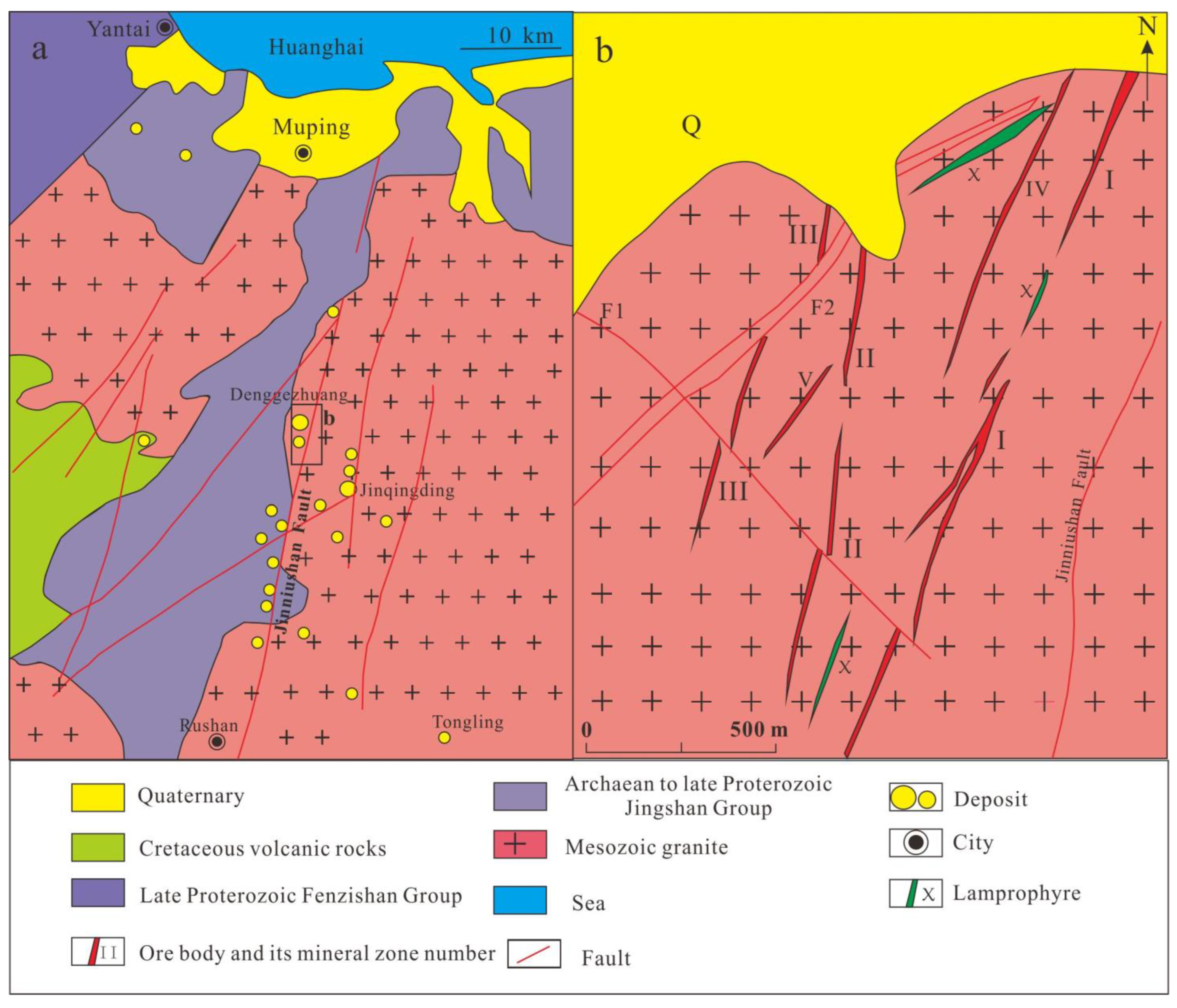
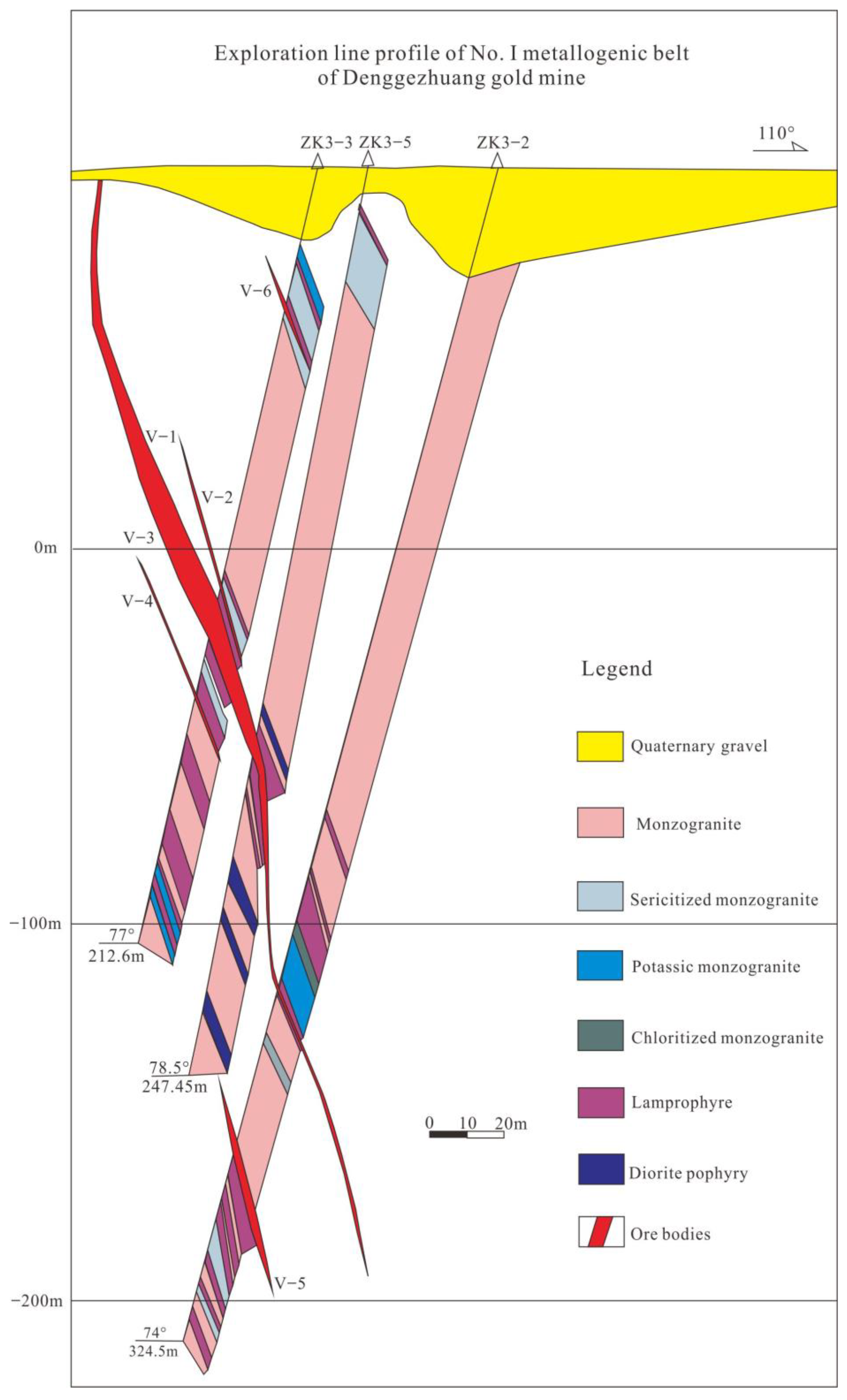
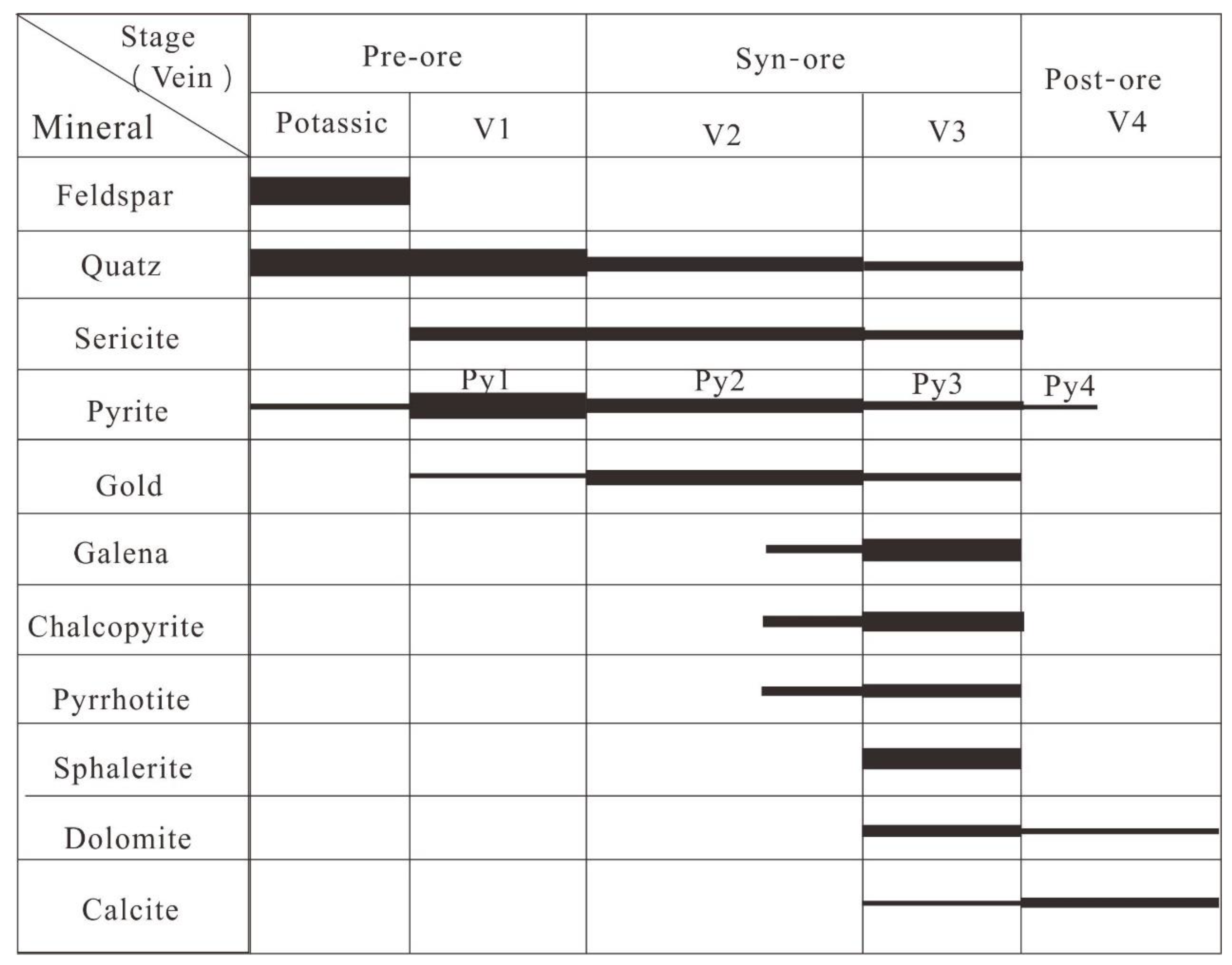
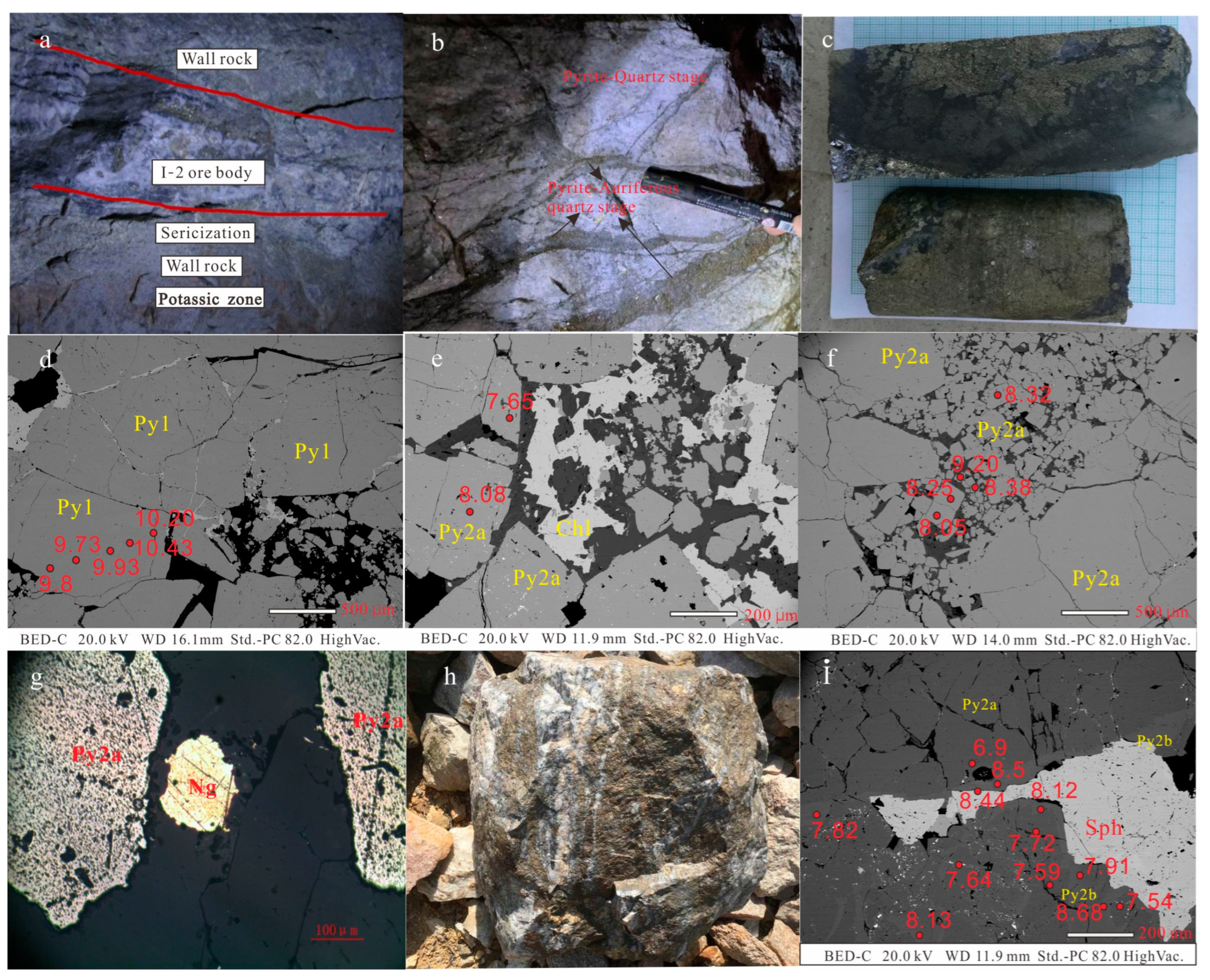
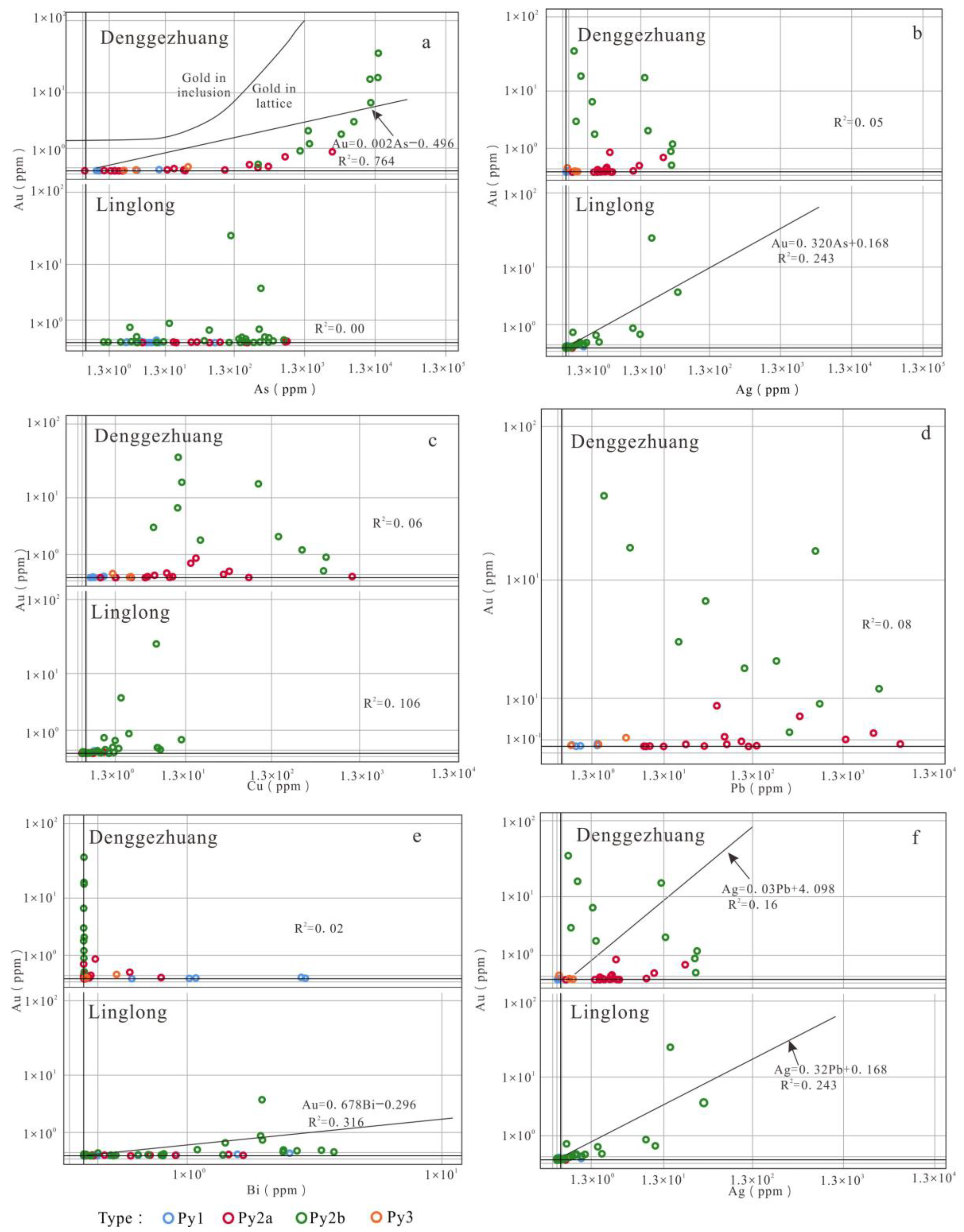
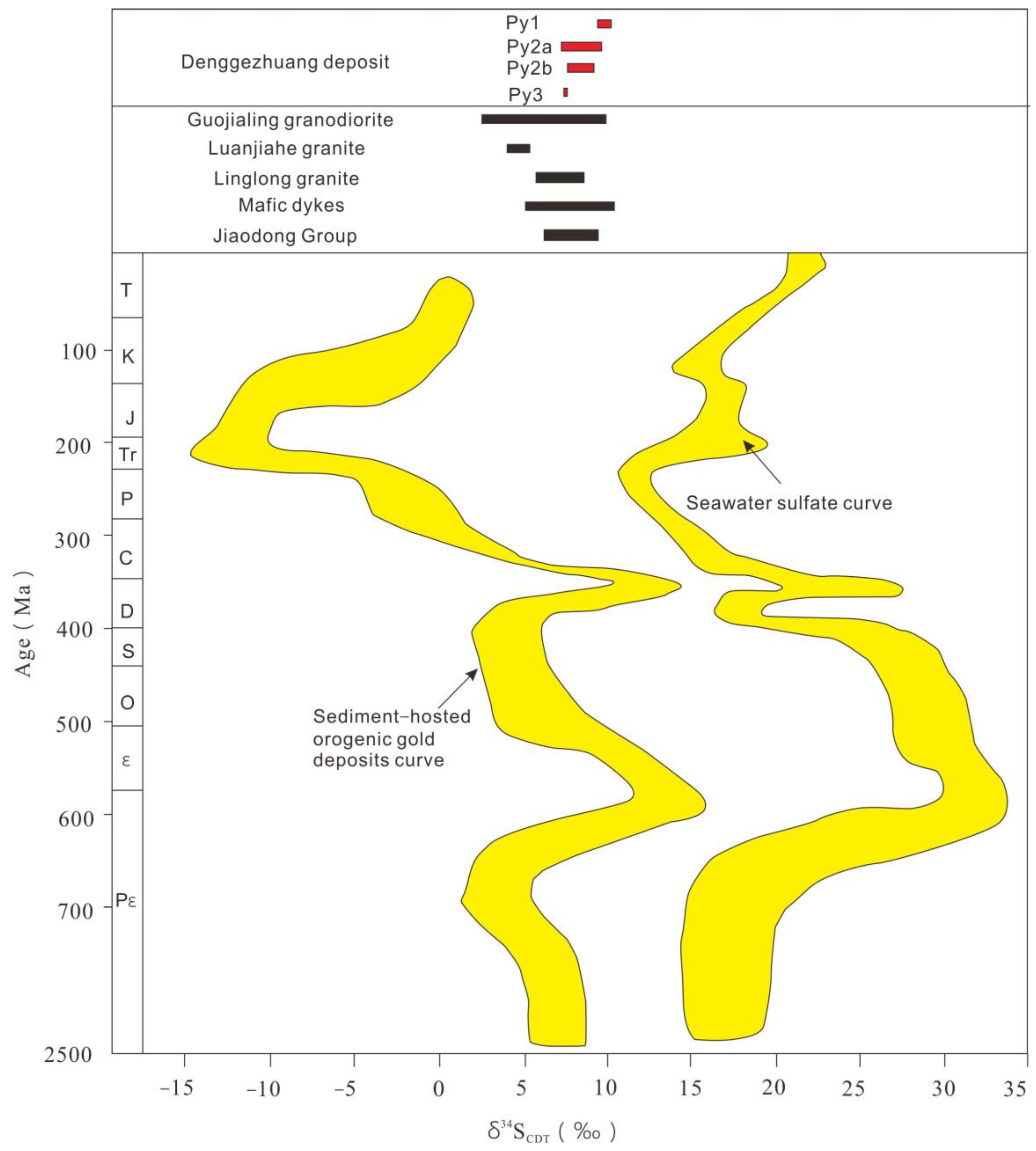
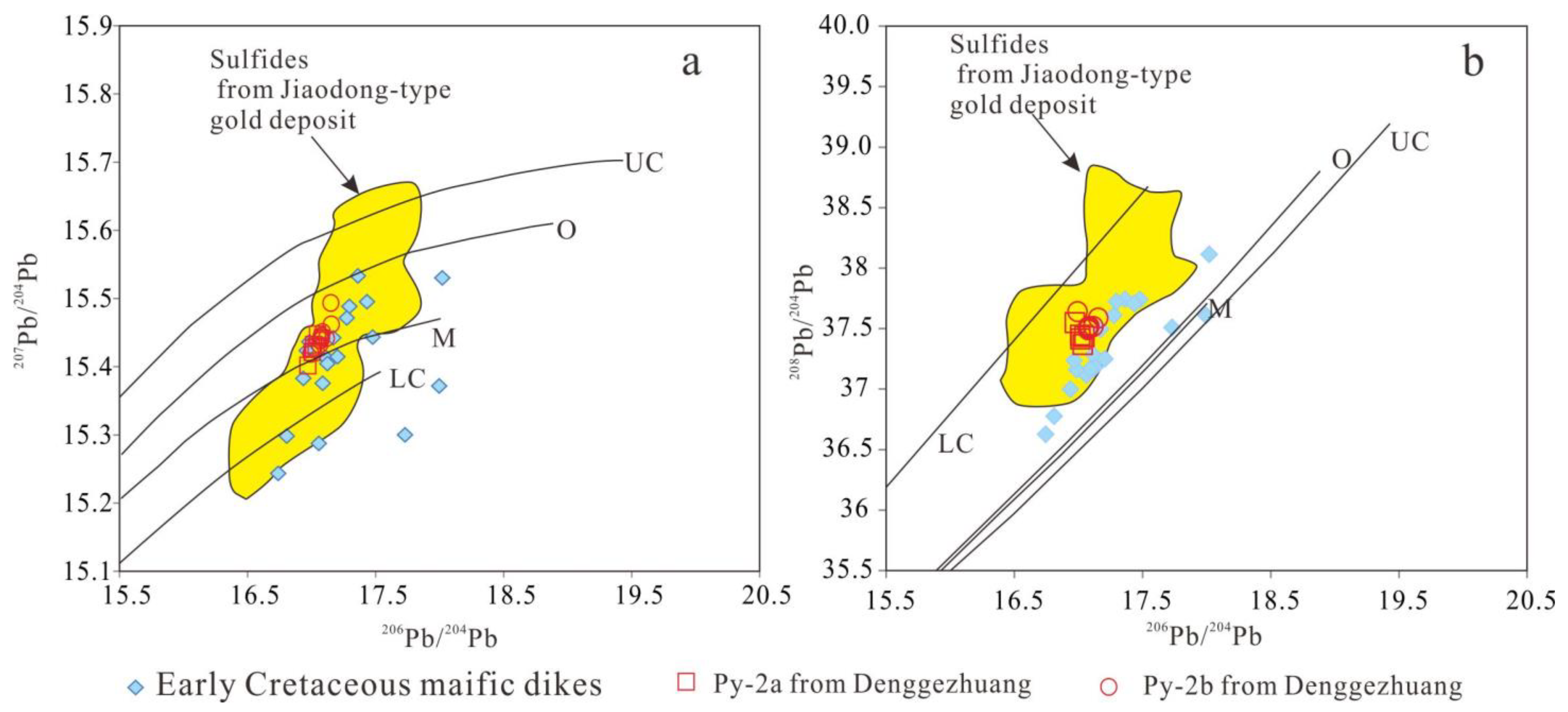
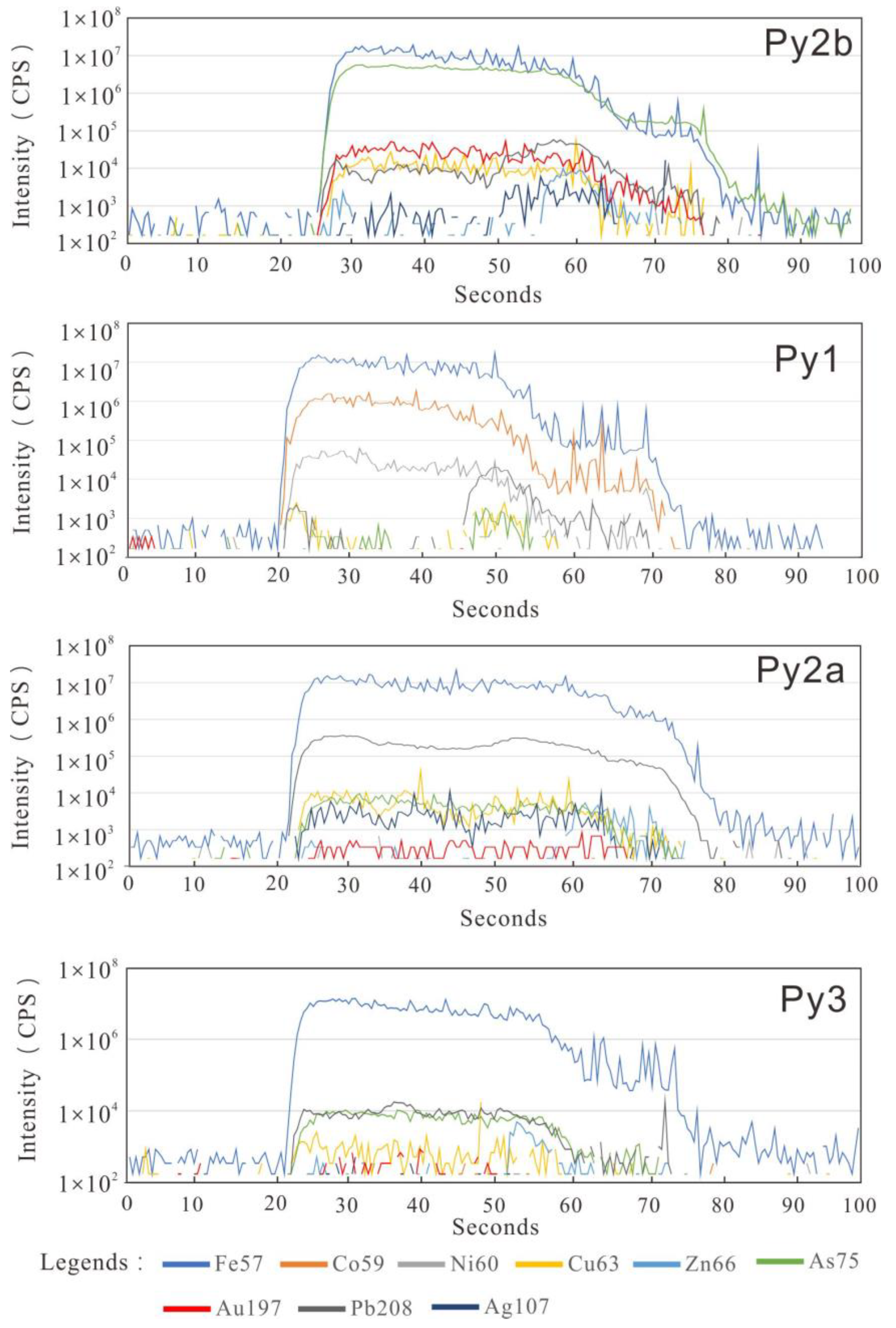
Disclaimer/Publisher’s Note: The statements, opinions and data contained in all publications are solely those of the individual author(s) and contributor(s) and not of MDPI and/or the editor(s). MDPI and/or the editor(s) disclaim responsibility for any injury to people or property resulting from any ideas, methods, instructions or products referred to in the content. |
© 2024 by the authors. Licensee MDPI, Basel, Switzerland. This article is an open access article distributed under the terms and conditions of the Creative Commons Attribution (CC BY) license (https://creativecommons.org/licenses/by/4.0/).
Share and Cite
Zhang, J.; Ding, Z.; Bo, J.; Ji, P.; Li, T.; Xin, W. In Situ Trace Element and S-Pb Isotope Study of Pyrite from the Denggezhuang Gold Deposit in the Jiaodong Peninsula—Insights into the Occurrence of Gold and the Source of Ore-Forming Materials. Minerals 2024, 14, 158. https://doi.org/10.3390/min14020158
Zhang J, Ding Z, Bo J, Ji P, Li T, Xin W. In Situ Trace Element and S-Pb Isotope Study of Pyrite from the Denggezhuang Gold Deposit in the Jiaodong Peninsula—Insights into the Occurrence of Gold and the Source of Ore-Forming Materials. Minerals. 2024; 14(2):158. https://doi.org/10.3390/min14020158
Chicago/Turabian StyleZhang, Junjin, Zhengjiang Ding, Junwei Bo, Pan Ji, Tingting Li, and Wei Xin. 2024. "In Situ Trace Element and S-Pb Isotope Study of Pyrite from the Denggezhuang Gold Deposit in the Jiaodong Peninsula—Insights into the Occurrence of Gold and the Source of Ore-Forming Materials" Minerals 14, no. 2: 158. https://doi.org/10.3390/min14020158



